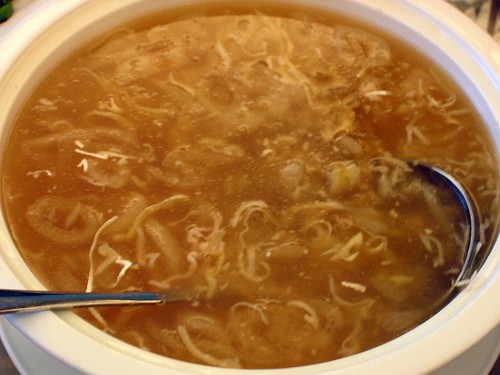
We had a call last week from a reader who was upset that a new Chinese restaurant in Irvine had shark's fin soup on the menu.
So what's the big deal about shark's fin anyway?
]
Let's start with what shark's fin tastes like: nothing. The initial reaction of pretty much every Westerner eating shark's fin for the first time is that it has almost no taste. It isn't there for the taste; Asians prize texture as much as taste in their food, and the fins are theoretically there for the snappy, gelatinous texture they give a soup.
Really, though, shark's fin is used as a way of showing respect to one's guests (by providing extremely expensive food), or simply as a way of showing off (by having the ability to provide extremely expensive food). It's practically de rigueur at weddings and other similar lavish banquets.
So what is it, exactly? Shark's fin is the dried dorsal and pectoral fins of sharks, especially mako and blue sharks (which are larger, thus the fins are larger and more valuable). It has essentially one use in Chinese cooking: shark's fin soup, which is a broth with chicken, shiitake mushrooms and Jinhua ham. The fin is cooked in the soup until it separates into noodle-like shards.
The controversy surrounding shark's fin, and the reason for its not-inconsiderable expense ($40-$50 per fin, with at least one fin per portion of soup), is the method of harvest. The process, known as “finning”, involves catching the shark, cutting off its two largest fins, and throwing the rest of the shark, mutilated and bleeding, overboard. The shark doesn't usually die from being finned; instead, it drifts, unable to move efficiently, until it either dies of trauma, dies of starvation or is eaten by a predator.

Shark's fin would be a much, much less objectionable ingredient if the fishers would harvest the entire shark. Most groups calling for boycotts of shark's fin and restaurants that serve it favor a ban on finning, not a ban on shark's fin. Shark's fin is illegal to import into the United States unless it is accompanied by the remaining carcass; there are, unfortunately, a bunch of ways around this rule.
Why not just fish for the shark and butcher the fish back on shore? There's almost no international demand for shark meat, which is a very strong-tasting fish. Unless there's a sudden resurgence of popularity of the meat (perhaps hákarl, the ammoniac fermented shark dish that's the Icelandic national excuse for drinking?), the demand for the fins will always outstrip the demand for the meat. Boats have limited storage space, and the owners would rather bring back a hold full of valuable fins, rather than whole, heavy fish.
There is fake shark's fin out there, meant to approximate the fin itself in soup while preserving the niceties of sustainability and animal rights; it's made from mung bean starch shaped like shark's fin. Unfortunately, it's almost completely unlike real shark's fin; anyone who's ever had the real article is going to be able to spot the impostor right away.

